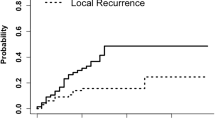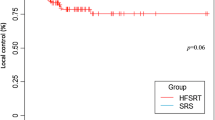Abstract
We retrospectively evaluated and compared the efficacy and the toxicity profile of stereotactic radiosurgery (SRS) and fractionated stereotactic radiotherapy (FSRT) for the treatment of patients with brain metastases (BM). Between 2000 and 2009, 260 patients with 1–3 BM were treated using either SRS (median dose 20 Gy; n = 138) or two different FSRT dose concepts: 7 × 5 Gy (n = 61) or 10 × 4 Gy (n = 61). The median survival for SRS, 7 × 5 Gy and 10 × 4 Gy was 8, 7 and 10 months (p = 0.575), respectively, and the overall survival (OS) was 9 months. Follow-up imaging data were available in 214 of the 260 patients. The 1-year local progression-free survival (LPFS) was 73, 75 and 71 %, respectively (p = 0.191). After a mean follow-up of 28 months (range: 2.1–77 months), the rate of complete remission, partial remission, stable disease and progressive disease were 29, 40, 21 and 10 %, respectively. On multivariate analysis, RPA class I was associated with better OS and regional progression-free survival (both p < 0.001). SRS was associated with a higher toxicity rate (grade I–III) compared to the 7 × 5 Gy and 10 × 4 Gy groups (14 vs. 6 vs. 2 %, respectively; p = 0.01). Although FSRT was used for large lesions and/or lesions near critical structures, the LPFS was comparable to SRS. Importantly, FSRT presented low toxicity and appears to be an effective and safe treatment for BM not amenable to SRS. The 10 × 4 Gy fractionation scheme warrants further investigation due to its efficacy and safe toxicity profile.

Similar content being viewed by others
References
Soffietti R, Ruda R, Trevisan E (2008) Brain metastases: current management and new developments. Curr Opin Oncol 20:676–684
Scoccianti S, Ricardi U (2012) Treatment of brain metastases: review of phase III randomized controlled trials. Radiother Oncol 102:168–179
Linskey ME, Andrews DW, Asher AL, Burri SH, Kondziolka D, Robinson PD, Ammirati M, Cobbs CS, Gaspar LE, Loeffler JS, McDermott M, Mehta MP, Mikkelsen T, Olson JJ, Paleologos NA, Patchell RA, Ryken TC, Kalkanis SN (2010) The role of stereotactic radiosurgery in the management of patients with newly diagnosed brain metastases: a systematic review and evidence-based clinical practice guideline. J Neurooncol 96:45–68
Mehta MP, Tsao MN, Whelan TJ, Morris DE, Hayman JA, Flickinger JC, Mills M, Rogers CL, Souhami L (2005) The American Society for Therapeutic Radiology and Oncology (ASTRO) evidence-based review of the role of radiosurgery for brain metastases. Int J Radiat Oncol Biol Phys 63:37–46
Aoyama H, Shirato H, Tago M, Nakagawa K, Toyoda T, Hatano K, Kenjyo M, Oya N, Hirota S, Shioura H, Kunieda E, Inomata T, Hayakawa K, Katoh N, Kobashi G (2006) Stereotactic radiosurgery plus whole-brain radiation therapy vs. stereotactic radiosurgery alone for treatment of brain metastases: a randomized controlled trial. JAMA 295:2483–2491
Kocher M, Soffietti R, Abacioglu U, Villa S, Fauchon F, Baumert BG, Fariselli L, Tzuk-Shina T, Kortmann RD, Carrie C, Ben Hassel M, Kouri M, Valeinis E, van den Berge D, Collette S, Collette L, Mueller RP (2011) Adjuvant whole-brain radiotherapy versus observation after radiosurgery or surgical resection of one to three cerebral metastases: results of the EORTC 22952-26001 study. J Clin Oncol 29:134–141
Shaw E, Scott C, Souhami L, Dinapoli R, Kline R, Loeffler J, Farnan N (2000) Single dose radiosurgical treatment of recurrent previously irradiated primary brain tumors and brain metastases: final report of RTOG protocol 90-05. Int J Radiat Oncol Biol Phys 47:291–298
Kwon AK, Dibiase SJ, Wang B, Hughes SL, Milcarek B, Zhu Y (2009) Hypofractionated stereotactic radiotherapy for the treatment of brain metastases. Cancer 115:890–898
Fahrig A, Ganslandt O, Lambrecht U, Grabenbauer G, Kleinert G, Sauer R, Hamm K (2007) Hypofractionated stereotactic radiotherapy for brain metastases: results from three different dose concepts. Strahlenther Onkol 183:625–630
Ernst-Stecken A, Jeske I, Hess A, Rodel F, Ganslandt O, Grabenbauer G, Sauer R, Brune K, Blumcke I (2007) Hypofractionated stereotactic radiotherapy to the rat hippocampus. Determination of dose response and tolerance. Strahlenther Onkol 183:440–446
Aoyama H, Shirato H, Onimaru R, Kagei K, Ikeda J, Ishii N, Sawamura Y, Miyasaka K (2003) Hypofractionated stereotactic radiotherapy alone without whole-brain irradiation for patients with solitary and oligo brain metastasis using noninvasive fixation of the skull. Int J Radiat Oncol Biol Phys 56:793–800
Kim YJ, Cho KH, Kim JY, Lim YK, Min HS, Lee SH, Kim HJ, Gwak HS, Yoo H (2011) Single-dose versus fractionated stereotactic radiotherapy for brain metastases. Int J Radiat Oncol Biol Phys 81:483–489
Lindvall P, Bergstrom P, Lofroth PO, TommyBergenheim A (2009) A comparison between surgical resection in combination with WBRT or hypofractionated stereotactic irradiation in the treatment of solitary brain metastases. Acta Neurochir (Wien) 151:1053–1059
De Salles AA, Hariz M, Bajada CL, Goetsch S, Bergenheim T, Selch M, Holly FE, Solberg T, Becker DP (1993) Comparison between radiosurgery and stereotactic fractionated radiation for the treatment of brain metastases. Acta Neurochir Suppl (Wien) 58:115–118
Tokuuye K, Akine Y, Sumi M, Kagami Y, Murayama S, Nakayama H, Ikeda H, Tanaka M, Shibui S, Nomura K (1998) Fractionated stereotactic radiotherapy of small intracranial malignancies. Int J Radiat Oncol Biol Phys 42:989–994
Henzel M, Gross MW, Hamm K, Surber G, Kleinert G, Failing T, Strassmann G, Engenhart-Cabillic R (2006) Significant tumor volume reduction of meningiomas after stereotactic radiotherapy: results of a prospective multicenter study. Neurosurgery 59:1188–1194, discussion 1194
Fokas E, Henzel M, Hamm K, Surber G, Kleinert G, Engenhart-Cabillic R (2010) Radiotherapy for brain metastases from renal cell cancer: should whole-brain radiotherapy be added to stereotactic radiosurgery?: analysis of 88 patients. Strahlenther Onkol 186:210–217
Emami B, Lyman J, Brown A, Coia L, Goitein M, Munzenrider JE, Shank B, Solin LJ, Wesson M (1991) Tolerance of normal tissue to therapeutic irradiation. Int J Radiat Oncol Biol Phys 21:109–122
Stafford SL, Pollock BE, Leavitt JA, Foote RL, Brown PD, Link MJ, Gorman DA, Schomberg PJ (2003) A study on the radiation tolerance of the optic nerves and chiasm after stereotactic radiosurgery. Int J Radiat Oncol 55:1177–1181
Manning MA, Cardinale RM, Benedict SH, Kavanagh BD, Zwicker RD, Amir C, Broaddus WC (2000) Hypofractionated stereotactic radiotherapy as an alternative to radiosurgery for the treatment of patients with brain metastases. Int J Radiat Oncol Biol Phys 47:603–608
Ernst-Stecken A, Ganslandt O, Lambrecht U, Sauer R, Grabenbauer G (2006) Phase II trial of hypofractionated stereotactic radiotherapy for brain metastases: results and toxicity. Radiother Oncol 81:18–24
Andrews DW, Scott CB, Sperduto PW, Flanders AE, Gaspar LE, Schell MC, Werner-Wasik M, Demas W, Ryu J, Bahary JP, Souhami L, Rotman M, Mehta MP, Curran WJ Jr (2004) Whole brain radiation therapy with or without stereotactic radiosurgery boost for patients with one to three brain metastases: phase III results of the RTOG 9508 randomised trial. Lancet 363:1665–1672
Mehta MP, Paleologos NA, Mikkelsen T, Robinson PD, Ammirati M, Andrews DW, Asher AL, Burri SH, Cobbs CS, Gaspar LE, Kondziolka D, Linskey ME, Loeffler JS, McDermott M, Olson JJ, Patchell RA, Ryken TC, Kalkanis SN (2010) The role of chemotherapy in the management of newly diagnosed brain metastases: a systematic review and evidence-based clinical practice guideline. J Neurooncol 96:71–83
Brenner DJ (2008) The linear-quadratic model is an appropriate methodology for determining isoeffective doses at large doses per fraction. Semin Radiat Oncol 18:234–239
Narayana A, Chang J, Yenice K, Chan K, Lymberis S, Brennan C, Gutin PH (2007) Hypofractionated stereotactic radiotherapy using intensity-modulated radiotherapy in patients with one or two brain metastases. Stereotact Funct Neurosurg 85:82–87
Conflict of interest
The authors declare that they have no conflict of interest.
Author information
Authors and Affiliations
Corresponding author
Additional information
Klaus Hamm and Rita Engenhart-Cabillic are co-senior authors.
Rights and permissions
About this article
Cite this article
Fokas, E., Henzel, M., Surber, G. et al. Stereotactic radiosurgery and fractionated stereotactic radiotherapy: comparison of efficacy and toxicity in 260 patients with brain metastases. J Neurooncol 109, 91–98 (2012). https://doi.org/10.1007/s11060-012-0868-6
Received:
Accepted:
Published:
Issue Date:
DOI: https://doi.org/10.1007/s11060-012-0868-6




